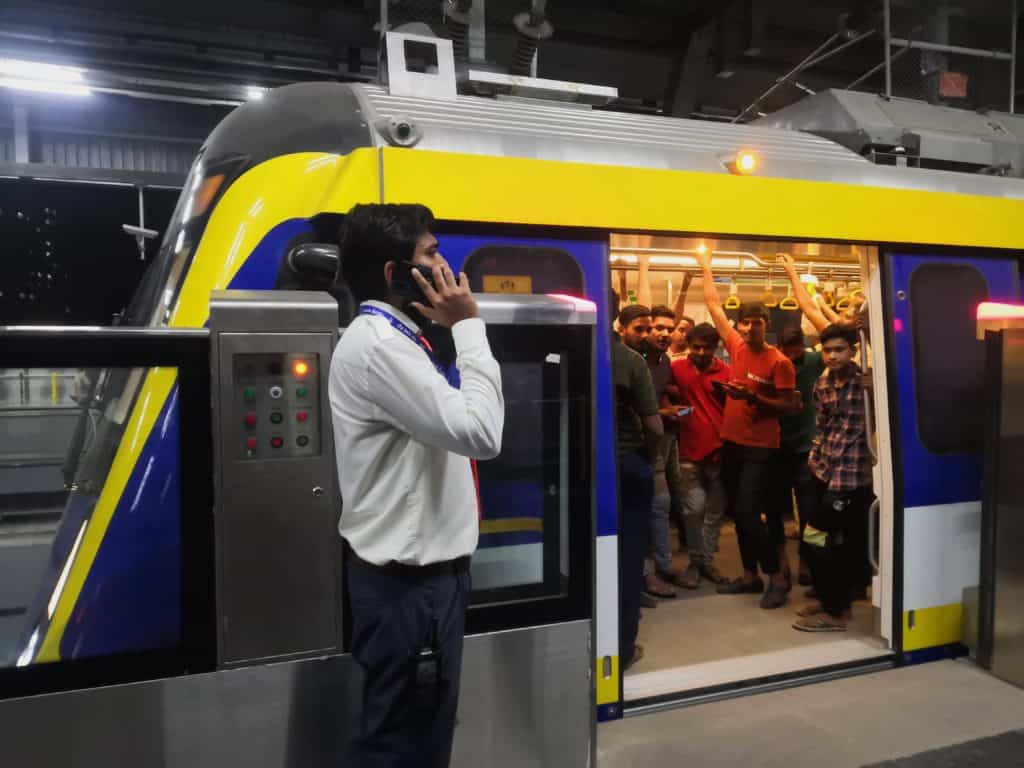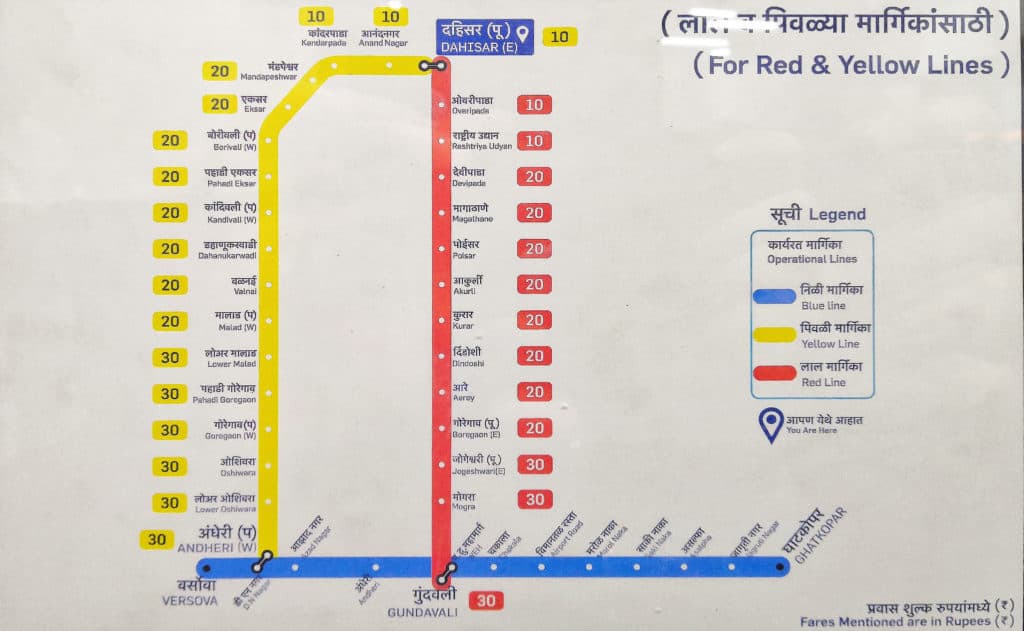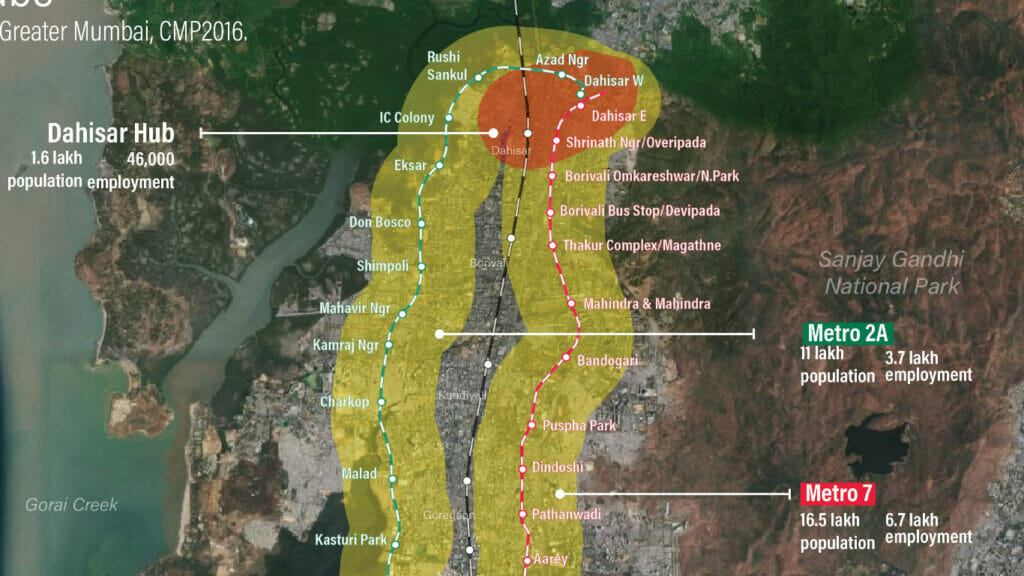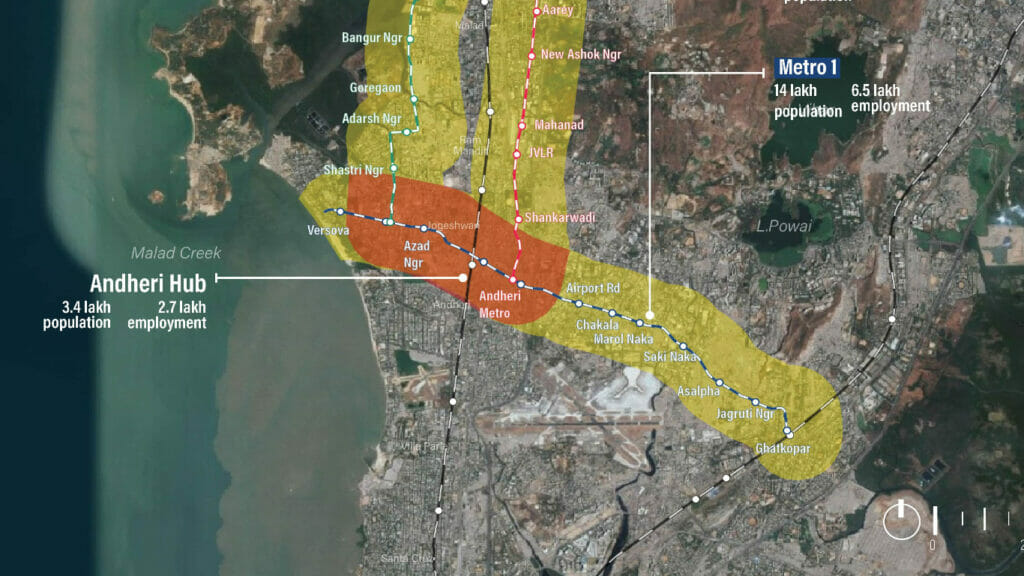In the first part of the story, we looked at Mumbai’s AC trains, evaluating whether they are attracting car users off the roads and improving traffic in Mumbai. In Part 2, we shift our attention to the Mumbai Metro, which nears a decade since beginning operations in the city.
When Gokhale bridge, a connector between the East and West sides of Andheri, closed for repair on Monday, November 7th, alternative routes suggested by the traffic police saw congestion and traffic jams. Some people, however, chose to park their cars and use the metro. Till 5 pm that day, 11,000 more passengers boarded the Mumbai metro.
Three weeks since, an excess of 40,000 people are flocking towards the metro; the daily footfall has increased to 3.80 lakh from 3.40 lakh before the closure of the bridge, although some of it is due to the end of the holiday season.
A similar transfer took place in January 2019, when a BEST bus workers’ strike saw the metro greet an additional 55,000 passengers daily. The 27 bus routes along the Versova-Ghatkopar corridor were at a halt, leaving commuters with the only other option of expensive rickshaws. Evidently, they chose the metro, taking its daily ridership to a record high of 5.2 lakh.
But not for long; as the BEST buses restarted and reduced their minimum fare to Rs 5, people went back. The cheaper, more extensive network was better suited for short 5 km journeys, which formed the majority of travel. A direct ride also cancelled the need to look for last-mile connectivity options. When it comes to private vehicles, as in the case of the Gokhale bridge closure, will the effect be the same?
“People anticipated the congestion on the roads,” says Vishal Ramprasad, senior manager of the sustainable cities and transport program at WRI. “If you’re going to be stuck on the road, but you’re offered a comfortable ride in the mero for a shorter duration, it motivates people to shift from their cars.”

Mumbai Metro Line 1
Since the start of the Mumbai metro Line 1 – between Versova and Ghatkopar through Andheri – in 2014, it has widely been considered a success. It crossed a passenger count of 25 crore people within the first 100 days, faster than any other line in the country. Before the pandemic in 2020, it had surpassed its daily ridership goal of 4.2 lakh in six years.
“The metro Line 1 provides much needed east-west connectivity, which is very limited in Mumbai,” says Pawan Mulukutla, director of the clean mobility and energy tech program at WRI India. “But because it also connects two suburban railway stations” – Andheri on the Western Railway (WR) and Ghatkopar on the Central Railway (CR) – “It is also used by railway users.”
Vishal wagers that 60% of the metro’s peak time footfall comes from the railway stations, as it eliminates the need for multiple switches. Without it, shifting from one railway line to the other can be done at Dadar station, which is one of the most crowded stations and is a stop for many long distance trains. The switch can also be through the connecting foot-over bridge between Matunga and Matunga West, and Prabhadevi and Parel stations, the mill district where many commercial offices are located.
The metro and monorail combined occupied 2.2% of the mode share in the MMR region by 2017. However, it did not manage to offset the downward trend in the use of public transport. Railway use dropped by 9%, and buses by 6%. On the other hand, the use of cars and two-wheelers saw a spike of around 4 percentage each.
Read more: Are AC trains in Mumbai attracting car users off the roads?
Ridership
“Traffic has reduced by around 25% since the start of the metro, but it has reached the same level as before the lockdown,” says the traffic police officer stationed at DN Nagar, which falls between the Andheri and Versova metro stations. This is in contrast to the ridership in the metro and railways, which are yet to reach their pre-pandemic ridership levels.
An updated comprehensive transport study pending, the number of private vehicles in Mumbai has only increased, sales accelerating every year. Compared to the pre-pandemic year of 2019, the first six months of 2022 saw a 28 percentage increase in car registrations; taking the total number to over 12 lakh. With two-wheelers, buses and trucks added, the total nears 43 lakh.
“We’re continuously seeing an increase in the mobility needs of people and the sales of cars,” says Rishi Aggarwal, director of the non-profit Mumbai Sustainability Centre. This has led to dwindling road space, occupied not only by moving but also by parked cars. Each kilometre of road has 600 cars taking up space, making Mumbai the city with the highest car density in the country.
Rishi also has doubts about the metro line having a direct impact on traffic. “From the time the metro Line 1 has started, a lot more commercial and residential properties have come up in the Andheri-Ghatkopar corridor. My reading is that the users of the metro at peak times are not car users,” he says.

The expectant lines Metro 2A and 7
The story of the Mumbai metro has only just begun.
The city got its two newest metro lines – 2A and 7 – in April. The lines start at the common station in Dahisar, extending parallelly Dahanukarwadi and Aarey respectively. For now, they are used sparingly, with an average 27,000 people boarding them in a day. Their combined ridership goal for 2031 is 11.37 lakh passengers daily.
“There has been no real reduction in traffic after the start of the metro here,” says a traffic police officer at the traffic chowki near the Sanjay Gandhi National Park (SGNP) in Borivali. But this, he suspects, is because the lines have yet to fully start. Both the lines are currently not connected to the existing railways and metro Line 1, with only buses for last-mile connectivity through public transport.

Come December, if the completion goes to plan, things may change. The lines will intersect Line 1, giving commuters from Andheri a parallel alternative to the suburban railway up to Dahisar.
“That corridor is so dense,” says Rishi, “the lines will help reduce the pressure on both the WEH and WR. If you live in a 1 km radius around any of the stations, there won’t be a reason to take out your car.” He adds, however, that walkability and last-mile connectivity will have to improve to meet this end.


A network in waiting
Once fully in operation, the three metro lines will be in close vicinity to 1.4 million jobs and 3.7 million people.
But this is not all. 14 metro lines are in the pipeline for Mumbai in total, promising an eventual overhaul of Mumbai’s public transport network. The much-anticipated underground Line 3, from Colaba to Bandra to SEEPZ, expects to bring aboard 17 lakh people and offroad 7 lakh vehicles.
“One single line isn’t going to make a significant dent in traffic. We need to look at the network when all the metro lines are operational, which offers good east-west connectivity, parallel north-south connectivity,” says Pawan.
Thank you, this article is really useful
No. Its purpose is to plug the connectivity gaps between Andheri and Ghatkopar stations for train and bus commuters. So it has helped these commuters to get to their destinations faster. Personally, I don’t think even the network of metro lines will take cars off the road as too many interchanges might add trab time to make it longer to reach the destination than in your car or SUV. Moreover, if 3 or more members of a family commute together, autorickshaws make better sense if you can bear the sweat.
It is a well know transportation FACT that congestion does not go down because of alternatives being available. If traffic goes down, more people tend to drive to take advantage of the reduced congestion, and congestion levels rise again until it reaches the same levels as before. Traffic is like a gas that expands to fully occupy any empty space.
The ONLY way to reduce congestion is to “price it”. Suppress demand by increasing the cost of driving or parking. Economics 101.
And if congestion does not decrease, then obviously neither will air pollution.
Alternatives like Metro help to make such pricing solutions politically palatable.